The Calle Mayor de Triana is the main street in the neighbourhood going by the same name, drawing on its commercial and seafaring origins.
Triana sprang up as the historical Vegueta neighbourhood expanded and nowadays, it is one of the city’s most important, bustling commercial zones.
Founded in the 15th century, the Royal City of Las Palmas began to grow and develop in an expansion project that would create one of the city’s most emblematic neighbourhoods, the Triana Neighbourhood.
Huge numbers of the conquerors hailed from Seville, and the parallels they drew with their home city led them to name this new neighbourhood and its most important street, La Calle Mayor de Triana, after Seville’s own Triana district.
It’s a street full of emblematic buildings and modernist houses rebuilt in the early 20th century, wide-ranging architecture, beautiful squares...but above all, a place brimming with life.
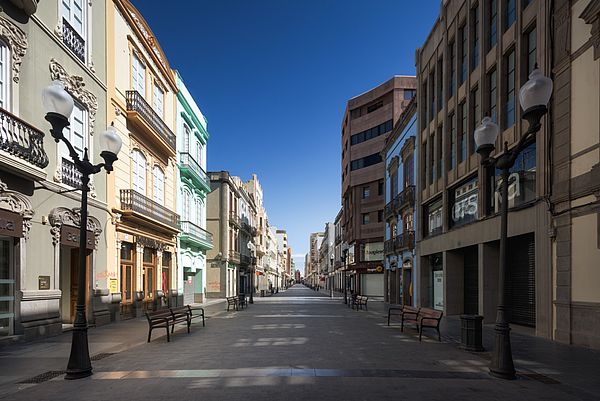
Now an open-air shopping area and one of the city’s prettiest streets, Triana is not to be missed when visiting the city of Las Palmas de Gran Canaria.
Shall we take a stroll around its most important spots?
Enjoy a pleasant stroll along one of its main shopping streets, the Calle Mayor de Triana, as a real treat for all your senses. Chock-full of incredible historical and artistic buildings, you'll constantly have to stop and admire its emblematic houses and modernist buildings.
The neighbourhood provides wonderful spots to meet up with friends such as the Plaza Hurtado Mendoza or the Plaza Cairasco, perfect to stop and grab a drink in one of their many outdoor cafés.
The area around Triana is home to several emblematic buildings such as the Pérez Galdós Theatre or The Benito Pérez Galdós House Museum, the birthplace of this well-known writer.
As the main street, Triana has been the site of many important historical events and has adapted to change without sacrificing its very essence.
The Calle Mayor de Triana welcomed the very first family businesses, seen today next to chain stores and swish international firms, all on show in this vast open-air shop window.
The city’s trams, popularly known as «La Pepa», used to run along this street and some of its rails can still be seen to this day.
This street brims with life all year round, particularly at Christmastime.
Triana is a pedestrian street, so it’s easy to explore on foot. Let’s take a stroll around its most important spots.
The San Telmo Park plays a very important role in this city’s history as the northern wall of Las Palmas was constructed here and stood until the 19th century. Some remains can still be seen today, such as the Castillo de Mata.
This park was built to receive passengers and sailors as they arrived or departed from the city.
The San Telmo hermitage (17th century) is a fine example of Mudejar architecture, with a Gothic-Renaissance façade and one of the most beautiful altarpieces in Gran Canaria. Another curiosity in this park is its unusual modernist kiosk (1924), one of the gems of this style on display in our city that still boasts its original decoration.
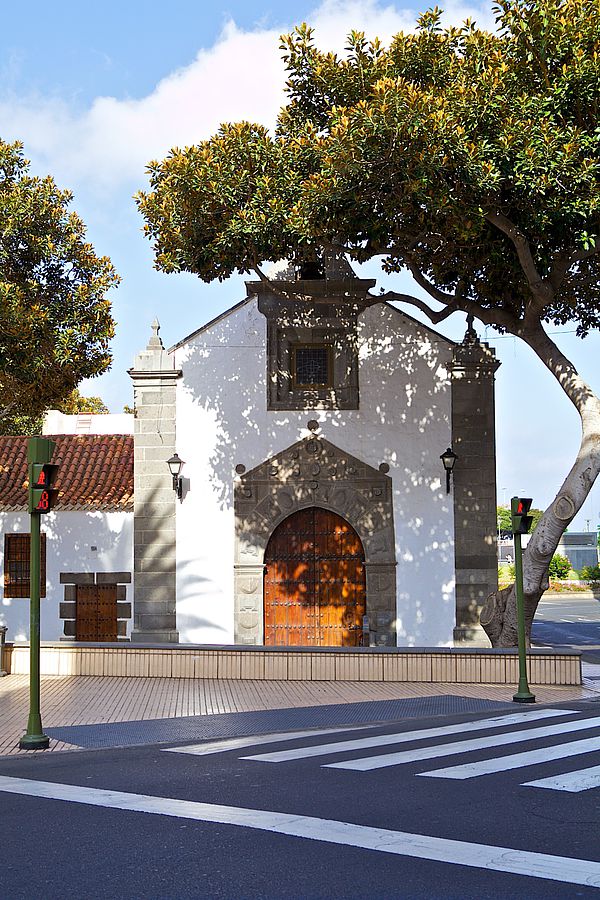
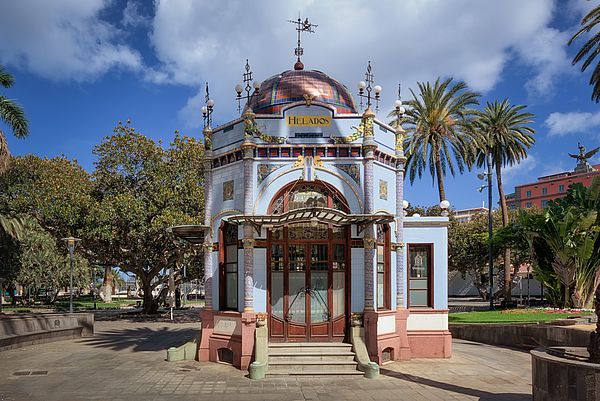
The Calle Mayor de Triana is nowadays one of the city’s most important open-air shopping and leisure areas and the main road through this emblematic neighbourhood.
All along this pedestrian street, you can also spot the important architectural legacy left by modernist buildings.
Make the most of this stroll to explore one of the most stately and best-preserved buildings in the city, El Palacete Rodríguez Quegles, located in the nearby Calle de San Bernardo.
The Palacete Rodríguez Quegles is one of the most majestic buildings in Triana. It was a private home until 1972 when the heirs sold it off to the City Council.
It was used as the Music Conservatory headquarters and is currently the institutional base for the Canary Island Government Department of Education.
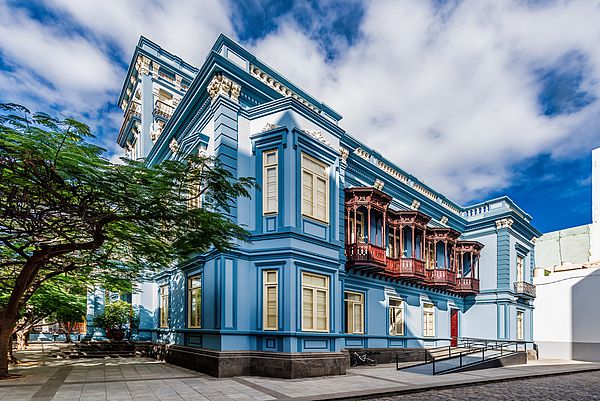
Our next stop delves into our island’s literary history. We are heading for the Pérez Galdós House Museum, to find out more about the life of this great 19th century Canarian writer.
The Canary Islands’ own novelist and playwright Benito Pérez Galdós was born in 1843, right behind Calle Triana, in Calle Cano to be precise. He went on to become a real figure of 19th century Spanish Realism.
His house is a unique piece of heritage, conserving museum pieces and an expansive archive of documents on his work, now turned into a Museum.
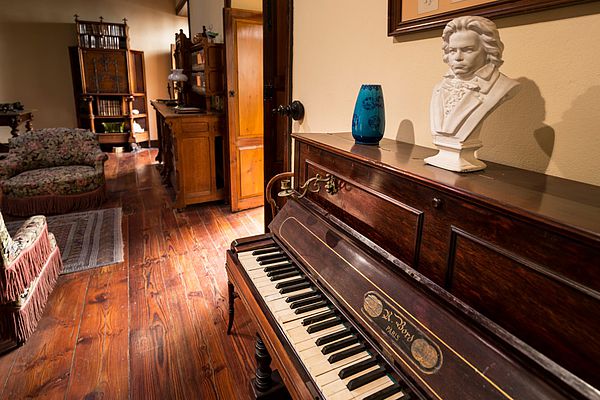
From the Pérez Galdos House Museum, we’ll head straight to the theatre that bears his name, one of the most important theatres in the city, just a few metres from this great writer’s home.
The Pérez Galdós Theatre is doubtlessly one of the most imposing buildings in the city. This building has played an important cultural role since it first opened in 1888, known as Tirso de Molina back in the day.
Its current name, paying homage to the immortal Benito Pérez Galdós, was adopted in 1901, following the successful run of his play, Electra.
The Pérez Galdós Theatre was completely renovated in 2007, becoming one of the most modern theatres in Spain and home to one of the city’s most important events, the Las Palmas Opera Festival.
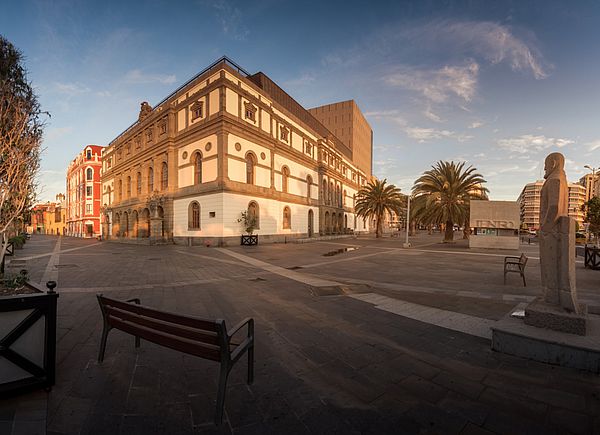
This mythical square (now popularly known as the “Plaza de las Ranas” or “Frog Square”) dates back to the early 19th century when the so-called Stone Bridge was built over the Guiniguada ravine, to make it easier to travel between the Vegueta and Triana neighbourhoods.
This square is home to the Island Library building and several kiosks, such as the Tourist Information Point.
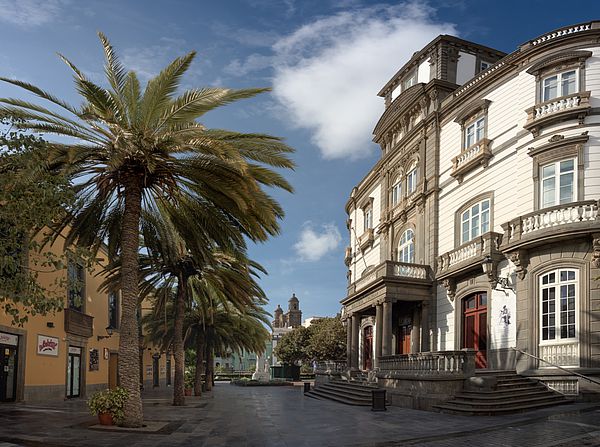
Let’s finish off our route through Triana by heading for the Plaza de Cairasco, next to the emblematic Gabinete Literario, the most cultural spot on our island.
We’ll finish off our walk in one of the Triana neighbourhood’s most characteristic spots, the Plaza de Cairasco.
Flanked by the Gabinete Literario, a modernist building dating from 1844 and an institution that has played a crucial role in the city's social and cultural life, this remarkable square has provided the backdrop for several movies. It is also home to the mythical Hotel Madrid, whose terrace still maintains a literary feel with its own particular fragrance of coffee and conversation.
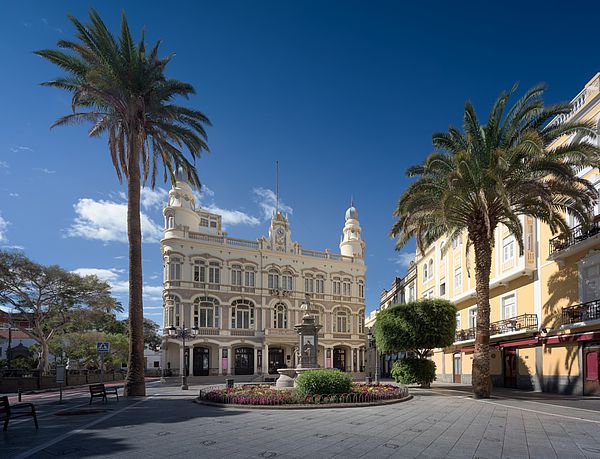
Opposite this square, in the adjoining Alameda de Colón the bust pays tribute to the explorer Christopher Columbus, reminding us of his stopover in the city before heading off on his transatlantic adventure. The square is also home to the Church of St Francis.
In 2013, the area of Triana (Triana Business Association) received the National Prize for Open-air Shopping Centres, awarded by Spain’s Ministry of Economy and Competitiveness domestic trade board to commercial associations that promote Open Air Shopping Centres.
In Calle Triana, you’ll find the Gran Canaria Tourism Board Information Office.
Address: Calle Triana, 93. 35003. Las Palmas de Gran Canaria.
Phone: 928 21 96 00
Website: http://www.grancanaria.com/turismo/